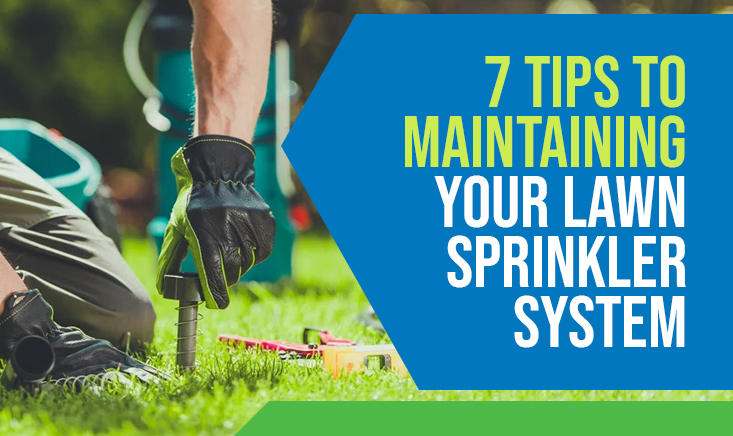Maintaining your lawn sprinkler system reduces water waste, prolongs the life of the equipment, and keeps your lawn healthy. But the procedures you should be following to do just that (and how often) depends on your system.
It’s not easy to quickly detect leaks and internal damage in sprinklers by viewing them from the outside. Following a maintenance regime helps determine whether the components of your sprinkler are working properly to reduce wastage of water.

A Simple Guide to Maintain Your Lawn Sprinkler System
Here are some tips to ensure your irrigation system is in good shape.
1. Open, Inspect, and Clean the Sprinkler Heads
When spring arrives, inspect your sprinkler heads for signs of damage from improper installation, vandalism, normal wear and tear, and lawnmowers. Make note of clogged nozzles and missing or broken parts. They can become clogged from a dirty water source or debris getting into the system which can affect its spray pattern.
When left unchecked, sprinkler heads/nozzles can be costly to repair. Any clogged parts should be cleaned; broken parts should be replaced to avoid water waste and make sure your lawn receives adequate water. Also, make sure that all the nozzles retract and pop up right when the water is turned off or on.
2. Check for Swampy Areas and Browning Grass
When checking the sprinkler heads, keep an eye out for areas with stagnant water and brown spots. If you notice swampy areas, chances are that the sprinkler head is delivering too much water or your drainage isn’t working properly. In this case, cut back on the water supply and look into the drainage. Browning grass probably means that the area isn’t receiving adequate water. This could be the result of clogging in the line or sprinkler head.
3. Adjust the Sprinkler Heads
Make sure your sprinkler heads are properly aligned so they water your lawn and not your driveway, streets, or sidewalks. Tilted heads can cause water to irrigate one side only and result in dry spots. Improperly aligned heads can contribute to wasted water and money.
It’s not as complicated as you may think. Just twist the spray head to align the nozzle pattern with the area it needs to irrigate.
4. Flush the System
You should ideally flush the system once in spring as the initial point of your lawn sprinkler system and nozzles could be clogged with debris. A contaminated water source or regular wear and tear can also result in the same.
Apart from flushing the system you should install screens on the sprinkler heads. This can enhance the filtration system and prevent clogs.
5. Optimize the Programming
If you have an automatic sprinkler system, set the timer (also called the controller) to water the grass. Remember, different types of grass have different water needs, so you should know how much water is required to set the controller.
Adjust the settings depending on the season so your lawn receives adequate water. Grass grows slower and requires less water during cooler months, as the water doesn’t evaporate as fast as during the warmer ones. Turn the controller off during extended periods of rain.
6. Upgrade to the Latest Technology
If you have a sprinkler that is less than five years old, chances are you can install a controller to improve the system’s efficiency.
Technology is rapidly evolving and homeowners looking to streamline this system can incorporate it into their property. New systems are available that allow homeowners to connect their sprinkler systems to the cloud and Wi-Fi to make programming changes when necessary. This can be done daily without much hassle or the need to focus on individual zone requirements.
By upgrading your sprinkler system, you enjoy the ease of accessibility and operation along with reducing water waste.
7. Contact a Professional
If these tips are overwhelming or you simply don’t have the time to do everything yourself, contact a professional contractor.
Though not necessary, having a professional maintain your lawn irrigation system ensures a more hands-off solution, especially for homeowners managing a large property. They can look into all the maintenance-related tasks mentioned here (and more). They will also be able to carry out necessary repairs, troubleshoot issues, and make programming adjustments.
Inspecting your sprinkler at regular intervals is very important because an efficient and well-maintained lawn sprinkler helps your lawn thrive. It might not be easy for you to follow a DIY sprinkler maintenance routine. Take help from experienced and reliable lawn sprinkler companies that offer seasonal care and ensure that your lawn irrigation system runs smoothly year-round.

